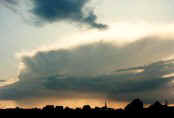| Legend Thick red line = atmosphere
sounding of temperature
Thick blue line = atmosphere sounding of dew point
Thick brown line = parcel sounding
Thin red lines = dry adiabatic laps rate
Thin green lines = saturated adiabatic lapse rate
Thin blue lines = lines of equal temperature (in °C)
Thin black lines = lines equal pressure heights (in hPa)
Thin yellow dotted lines & values = lines & values of humidity mixing ratio
(in g/kg)
On right = wind barbs in knots
In box:
K = K Index in °C
TT = total totals index in °C
PW = precipitable water for the entire sounding in cm
Temp = temperature on ground in °C
Dewp = dewpoint on ground in °C
θS = equivalent potential temperature in
°K (= measure for instability)
LI = lifted index in °C
CAPE = convective available potential energy in J/kg
CIN = convective inhibition in J/kg
EH = environmental helicity in m²/s²
SREH = storm relative environmental helicity in m²/s²
StrmDir = storm direction in degrees
StrmSpd = storm speed in knots
Thunderstorm forecasting
Legend instability indices:
K Index = thunderstorm potential
<20 = none
20-25 = isolated
26-30 = scattered
31-35 = scattered to numerous
>36 = numerous
Poor correlation between KI values and severe weather events, good
correlation KI < 26 and no thunderstorms.
TT = coverage of thunderstorm
44-45 = isolated
46-51 = scattered
52-55 = scattered to frequent
Good correlation between TT values > 48 and severe weather events.
PW = measure type of supercell thunderstorm
> 4,4 = high precipitation supercell
4,3-2,5 = supercell
< 2,50 = low precipitation supercell
Poor correlation between PW values and severe weather events, good
correlation PW < 1 and no thunderstorms.
LI = measure of severity of thunderstorm
>0 = unlike potential for
thunderstorms
0 - (-2) = possible potential with trigger (front, trough, orography).
-3 - (-5) = probable potential.
< -5 = strong potential
Good correlation between LI values < -5 and severe weather events.
CAPE = measure of severity of thunderstorm
<300 = little or no convective potential.
300-1000 = weak convective potential
1000-2500 = moderate convective potential
> 2500 = strong convective potential
Poor correlation between CAPE values and severe weather events.
Combination CAPE and 0-4km speed shear can give a hint on thunderstorm
type
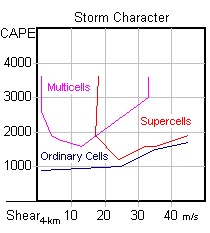
CIN = is the negative area on a sounding found between
the lifting condensation level and level of free convection.
< 25 = associated with significant tornadoes
50 = associated with derechoes
> 100 = precludes thunderstorm development without significant forcing
EH = measure of rotation potential
SREH = measure of rotation potential for (thunder)storms
if they form:
150-300 = supercell development possible with large CAPE, risk for weak tornadoes
(F0, F1)
300-450 = supercell development possible with small CAPE, risk for strong tornadoes
(F2, F3)
>450 = large risk for supercell development, risk for violent tornadoes (F4, F5)
Poor correlation between SREH values and severe weather events.
Hodograph: useful for evaluating vertical wind shear.
In convective environment it is a clue for type of thunderstorm,
likelihood of supercell, and storm system motion.
The depicted hodographs above go up to 250 hPa.
Hodograph read as: 1=ESE 24kt @ 950hPa, 2=S 43kt @ 850 hPa, 3=SW 52kt @ 700 hPa, 4=WSW 77kt @ 500 hPa, 5=W 97kt @ 300hPa. (Check also the wind
speed converter)
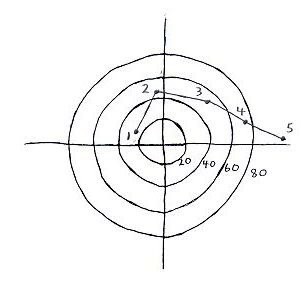
Types of hodographs and associated thunderstorms if they form:
Weak speed shear and weak
directional shear or weak speed shear and strong directional shear: single cell or pulse storm.
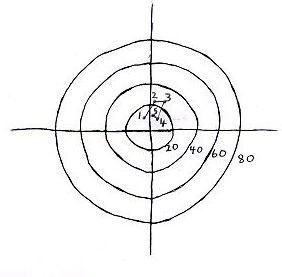
Strong speed shear and weak directional
shear: multicell thunderstorm.
If deep layer speed shear (sfc-6km is >35 knots): risk for supercell
thunderstorm which might split in a twin pair if directional shear is
straight.
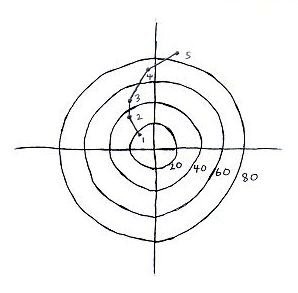
Strong speed shear and strong
directional shear: supercell thunderstorm.
If directional shear is clockwise (depicted): dominant right movers
If directional shear is anticlockwise (not depicted): dominant left
movers

Hail forecasting
One of the better indicators in forecasting hail is the zero degree
level of the wet bulb temperature.
To find the wet bulb construct a mean line between the curves of the
temperature and dew point and find the level were it crosses the 0°C.
Critical values for hail:
850-785 hPa (5000-7000ft or 1500-2120m) = small hail possible
785-725 hPa (7000-9000ft or 2120-2727m) = best conditions for large hail
725-685 hPa (9000-10500ft or 2727-3180m) = large hail is possible
< 685 hPa (>10500ft or > 3180m) = hail is unlikely
Snow forecasting
One of the best indicators in forecasting solid precipitation (snow) is
the zero degree level of the wet bulb temperature.
To find the wet bulb construct a mean line between the curves of the
temperature and dew point and find the level were it crosses the 0°C.
Critical values for snow:
< 900 hPa (>3000ft or 1000m) = rain (snow very exceptionally)
966-900 hPa (2000-3000ft or 600-1000m) = mostly rain (snow unlikely)
977-966 hPa (1000-2000ft or 300-600m) = rain turning into sleet / snow
> 977 hPa (<1000ft or <300m) = mostly snow
|
